A Three-Stage Super-Efficient SBM-DEA Analysis on Spatial Differentiation of Land Use Carbon Emission and Regional Efficiency in Shanxi Province, China
Abstract
1. Introduction
2. Methods
2.1. Study Area
2.2. Data
2.3. Research Methodology
2.3.1. Dynamic Changes in Land Use Types
2.3.2. Estimation of Land Use Carbon Emissions
2.4. Spatial Autocorrelation Analysis
2.4.1. Estimation of Land Use Carbon Emissions Efficiency
- Stage 1: Preliminary calculation of carbon emission efficiency valuesFor 11 cities (1990–2022) in Shanxi Province, the conventional DEA is replaced with a super-efficiency SBM model to better align with regional characteristics. Unlike radial DEA approaches that require proportional input-output adjustments, the SBM framework directly optimizes slack variables to quantify resource inefficiencies. The mathematical formulation of Stage 1 is detailed below:Here, and denote the input slack variables and the undesirable output slack variables, respectively, while represents the undesirable output shortfall variables. The parameters m, , and denote the number of input variables, desirable output variables, and undesirable output variables, respectively. For the j-th decision-making unit (DMU), correspond to its input vector, desirable output vector, and undesirable output vector, respectively, while represent the aggregate input, desirable output, and undesirable output values across all DMUs. Assuming there are m DMUs, indicates the weight coefficients for efficiency computation.Due to the nonlinear complexity of Equation (7), it is reformulated into an equivalent linear programming problem using mathematical manipulation. The linearized form is mathematically expressed as follows:Let and denote the solutions to Equations (7) and (8), respectively. These solutions satisfy the following relationships, as shown in Equation (9).
- Stage 2: Adjustment of input variablesThe super-efficiency SBM model is applied in the first stage to quantify input slack variables, but it produces efficiency estimates influenced by environmental heterogeneity and statistical noise. To address this methodological constraint, an SFA framework following Fried et al. (2002) was implemented using Frontier 4.1 software [30]. This approach statistically decomposes observed slack variables into three components: environmental factors, stochastic disturbances, and managerial inefficiencies. The decomposition enables precise identification of dominant environmental and stochastic influences. The SFA regression structure is mathematically defined as follows:Here, denotes the slack variable of the i-th input for the j-th DMU; represents the vector of environmental variables; is the vector of coefficients to be estimated; captures the influence of environmental variables on the slack variable , typically specified as a linear functional form. captures stochastic noise, assumed to follow a normal distribution with a mean of 0 and variance of , i.e., ; and reflects management inefficiency, assumed to follow a half-normal distribution . The composite error term assumes independence between and , with no cross-correlation.Environmental factors, stochastic noise, and managerial inefficiency were disentangled. Managerial inefficiency was isolated using the conditional decomposition method proposed by Luo et al. (2012) [41]:whereand denote the standard deviations of management inefficiency and stochastic noise, respectively; and represent the probability density function and cumulative distribution function of the standard normal distribution.Using Equation (11), the mixed error and random disturbance terms can be separated as follows:An SFA regression model was developed to eliminate environmental factors and stochastic noise in efficiency evaluation, ensuring that all DMUs operate under identical external conditions.Input variables were subsequently adjusted using Equation (13) after removing environmental and random effects through Equation (12):Here, denotes the adjusted input, and represents the original input. The adjustment has two components:Environmental equalization: neutralizes disparities caused by environmental heterogeneity, homogenizing external conditions across DMUs.Stochastic noise normalization: calibrates inputs by penalizing DMUs disproportionately affected by stochastic noise (increasing inputs for units with large stochastic noise; decreasing them otherwise).This dual adjustment ensures DMUs operate under environmental and stochastic noise baselines, enabling fair efficiency comparisons.
- Stage 3: Calculate the adjusted efficiency valuesThe adjusted efficiency values were measured using the super-efficiency SBM model. This process removed environmental factors and random disturbances from DMU efficiency assessments. The results reflect more authentic, effective efficiency under homogeneous conditions. This adjustment ensures that the efficiency values are determined solely by internal technological and managerial factors, enabling a fairer comparison of actual efficiency across DMUs.
- Robustness checksTo ensure the credibility of our findings, we conducted multiple robustness checks addressing key methodological concerns and parameter uncertainties.Water-body-neutral scenario: To test the core assumption of water bodies as a carbon sink—a primary source of uncertainty—a conservative sensitivity analysis was conducted by setting their net carbon flux to zero (). All other procedures (Section 2.3.2 and Section 2.4.1) remained unchanged. The high consistency in city efficiency rankings between this and the baseline scenario (Spearman’s , ; see Results Section 3.4.5) confirms the robustness of the comparative conclusions. A neutrality scenario for water bodies is reported in the Results section and detailed in Appendix A.Model specification checks: To account for potential spatial dependence in the second-stage SFA residuals, we employed a Spatial Error Model (SEM). The spatial weights matrix W was constructed based on the Queen contiguity criterion, whereby two geographical units are defined as neighbors if they share either a border or a vertex. A first-order contiguity matrix was adopted, considering only direct neighbors. The binary adjacency matrix ( if i and j are neighbors; 0 otherwise) was row-standardized so that each row sums to unity, ensuring comparability across units. The SEM was then specified aswhere u denotes the inefficiency residuals, the spatial autocorrelation coefficient, and the i.i.d. error term. An insignificant indicates negligible bias from spatial autocorrelation.Monte Carlo uncertainty analysis: To propagate uncertainty in land use emission coefficients (Table 1), we performed a 1000-iteration simulation. Coefficients were perturbed by (), and the entire analytical pipeline (Equation (4) AND SBM-DEA model) was rerun per iteration to quantify uncertainty in final efficiency scores.
- Selection of carbon emission efficiency evaluation indicatorsThe carbon emission efficiency evaluation system in this study is constructed based on a classical economic production framework to ensure scientific validity, consistency, and regional applicability. In this framework, three canonical factors of production—capital, labor, and land—are specified as inputs [42]. Specifically, land use categories directly participate in the socio-ecological production process: construction and cultivated land are essential for economic output, while forest and grassland directly contribute to carbon emissions and sinks. Environmental variables (e.g., urbanization rate and industrial structure) influence production efficiency but are not themselves consumed or transformed [30]. This classification aligns with established research on LUCE [43,44,45].DMUs and time horizon: The 11 prefecture-level cities in Shanxi Province were selected as Decision-Making Units (DMUs) for this study, observed at four time points: 1990, 2000, 2010, and 2022.Economic and social indicators: Data on capital stock, labor force, and GDP were collected from the Shanxi Statistical Yearbook and relevant prefecture-level yearbooks. The capital stock was estimated using the perpetual inventory method (PIM) [46], with a 9.6% annual depreciation rate, following standard methodology for estimating provincial capital stock in China. This ensures consistency and comparability with prior studies.Land use data: Land use data were obtained from the multi-period China Land Use/Cover Datasets (CNLUCC) with a 30 m resolution. Prefecture-level areas were derived using zonal statistics in ArcGIS.Land use carbon emissions: Carbon emissions were calculated by applying county-level carbon source/sink coefficients [7,43] and then aggregating them to the prefecture level.Green Technology Progress Index (GTPI): GTPI was measured as the proportion of green invention patents granted relative to total invention patents. Green patents were identified according to the WIPO Green Inventory, and data were retrieved from the China National Intellectual Property Administration (CNIPA). Complete variable definitions, measurement units, data sources, and processing methods are summarized in Table 3.
2.4.2. Machine Learning Framework for Driver Analysis
- Driver indicator framework and data preparationA comprehensive driver analysis framework for land use carbon emissions was constructed (Table 4), systematically covering five key dimensions: economic development, technological innovation, land use patterns, human activities, and natural conditions. The indicator selection followed a structured process emphasizing scientific relevance, empirical support, and representativeness, guided by the established literature [40].All drivers were converted into uniformly resolved raster datasets in ArcGIS. To construct the modeling dataset, 800 sample points were generated through stratified random sampling to ensure representative coverage across diverse land use types and spatial gradients. These samples formed the predictor-response dataset, with land use carbon emissions as the dependent variable. Prior to modeling, all numerical features were standardized via Z-score normalization to mitigate scale effects.
- Machine learning modeling and interpretationModel construction and optimization: To decipher the complex, nonlinear drivers of land use carbon emissions, the XGBoost algorithm was selected for its proven capability in handling high-dimensional data and capturing intricate feature interactions. The algorithm optimizes an objective function that balances prediction accuracy with model complexity:Model hyperparameters were optimized using Bayesian optimization over 100 iterations, yielding a final configuration: , , , , , , and .Feature interpretation using SHAP: To move beyond black-box predictions, SHAP (SHapley Additive exPlanations) values were employed to quantify the marginal contribution of each driver. The Shapley value for feature i is calculated asThe SHAP framework enables a systematic evaluation of both main effects and pairwise interactions among drivers.
- Model validation and robustness assessmentThe model’s robustness and spatial generalizability were evaluated through a dual validation approach. First, spatial k-fold cross-validation (k = 5) was implemented to assess performance on unseen geographic data, with metrics aggregated asSecond, a bootstrap resampling procedure (B = 500) evaluated the stability of driver importance rankings. The median rank () and interquartile range (IQR) across iterations identified consistent global drivers:
- Spatial heterogeneity analysisRegions exhibiting high prediction errors (e.g., Region 2 in Fold 3, ) were analyzed to uncover localized mechanisms. Welch’s t-tests and Cohen’s d effect sizes quantified feature differences between anomalous and typical regions:where and denoting group means, and and denoting their standard deviations. This analysis characterized the unique socio-ecological profiles leading to spatial heterogeneity in emissions.
3. Results
3.1. Land Use Changes in Shanxi Province
3.1.1. Rates of Land Use Change
3.1.2. Structural Changes in Land Use
3.2. Temporal Characteristics of Land Use Carbon Emission
3.3. Spatial Distribution Characteristics of Land Use Carbon Emission
3.4. Comprehensive Evaluation of Carbon Emission Efficiency Considering Environmental Factors
3.4.1. Empirical Results of the Stage 1 SBM Analysis
3.4.2. Results and Analysis of Stage 2 SFA Regression
3.4.3. Analysis of Adjusted SBM Results
3.4.4. Comparison of Stage 1 and Stage 3 Efficiency Scores Across Cities
3.4.5. Robustness Checks
3.5. Drivers of Land Use Carbon Emissions
3.5.1. Global Model Performance and Robust Driver Identification
3.5.2. Interaction Effects Among Robust Drivers
3.5.3. Spatial Heterogeneity and Model Transferability Assessment
3.5.4. Synthesis: Global Patterns and Local Exceptions
4. Discussion
4.1. Spatiotemporal Changes in Land Use Carbon Emission
4.2. Three-Stage SBM-DEA Methodology
4.3. Drivers of Land Use Carbon Emissions
4.4. Uniqueness and Future Prospects of the Research Findings
- This study introduces a method integrating a three-stage DEA framework with a super-efficiency SBM model, representing the pioneering application of this methodology to investigate the LUCE in Shanxi Province. The method delivers higher precision in setting LUCE benchmarks across DMUs. By carrying out this regional implementation in one of China’s resource-intensive provinces, it provides a new empirical reference for future research on spatial heterogeneity adjustment.
- Interpretable driver analysis through machine learning. The analytical framework combines extreme gradient boosting to capture nonlinear variable interactions with Shapley additive explanation values for causal attribution. Applied to Shanxi Province, it delivers fine-grained insights into how economic activity, UR, and GTPI adoption drive land use carbon emissions, providing clear, actionable guidance for targeted policy interventions.
- This study relies on longitudinal data spanning 1990 to 2022, which may limit its ability to capture nuanced temporal dynamics. Future research should adopt shorter-term cyclical analyses, such as five-year intervals, to improve temporal resolution and reduce data inconsistencies from prolonged observation periods. This adjustment could clarify phased characteristics of land use carbon emissions and policy impacts.
- This study measured LUCE at the city level, offering insights but lacking the spatial precision and policy relevance of micro-scale analyses. Future research should conduct assessments at the county level to improve practical applicability. A larger number of DMUs would support multidimensional evaluations of land use efficiency and enable a more comprehensive assessment of land use benefits.
5. Conclusions and Suggestions
5.1. Conclusions
- From 1990 to 2022, construction land expansion in Shanxi Province peaked during 1990–2000, with a dynamic degree of 4.96%, marking accelerated urbanization. Unused land contraction reached maximum intensity between 2000 and 2010 (−4.48% dynamic degree), reflecting effective ecological policy implementation. Cultivated land, grassland, and unused land exhibited persistent negative trends, contrasting with positive trajectories in forest land, water bodies, and construction land. These patterns demonstrate intertwined agricultural intensification, ecological rehabilitation, and urban development pressures. Post-2010 increases in comprehensive dynamic degree reveal sustained land system instability, necessitating integrated land management strategies and green urban planning to address systemic vulnerabilities.
- This study examined the key drivers of land use carbon emissions in Shanxi Province and assessed their robustness and spatial variability. Population indicators (POPS and POPD) and economic development (RGDP) were identified as the most influential drivers, while natural and technological factors played secondary or context-dependent roles. Pronounced spatial heterogeneity was observed, exemplified by Region 2, where the global model underperformed due to extreme socio-ecological conditions. These findings highlight the necessity of region-specific mitigation strategies. In areas with anomalous profiles, reliance on natural sinks alone is insufficient, and targeted regulation of industrial sources combined with energy modernization is critical. For such regions with concentrated, high-intensity emissions from industrial point sources (e.g., coal-fired power plants and chemical industries), our spatially explicit identification provides a scientific basis for prioritizing the deployment of advanced mitigation technologies, such as carbon capture, utilization, and storage (CCUS), in future infrastructure planning. Spatially explicit modeling frameworks are essential to accurately capture local dynamics and inform effective climate mitigation policy.
5.2. Suggestions
- 1.
- Contain urban sprawl in metros with declining scale efficiency
- 2.
- Drive industrial retrofitting in basin emission hotspots with low efficiency
- 3.
- Enhance carbon sinks in ecological zones with high sequestration potential
- 4.
- Implement differentiated spatial governance for spatially anomalous clusters
- 5.
- Mainstream climate resilience into planning for high-risk, high-emission areas
- 6.
- Institutionalize decomposed efficiency metrics into performance evaluations
Author Contributions
Funding
Institutional Review Board Statement
Informed Consent Statement
Data Availability Statement
Conflicts of Interest
Appendix A. Detailed Results of the Water-Body-Neutral Scenario Analysis
Appendix A.1. Overview
Appendix A.2. Spearman’s Rank Correlation Analysis
| Year | Efficiency Indicator | Spearman’s | p-Value | Interpretation |
|---|---|---|---|---|
| 1990 | TE | 0.855 | 0.001 | Significant |
| PTE | 0.391 | 0.232 | Not Significant | |
| SE | 0.927 | 0.000 | Significant | |
| 2000 | TE | 0.818 | 0.002 | Significant |
| PTE | 0.536 | 0.089 | Marginally Significant | |
| SE | 0.818 | 0.002 | Significant | |
| 2010 | TE | 0.845 | 0.001 | Significant |
| PTE | 0.564 | 0.071 | Marginally Significant | |
| SE | 0.927 | 0.000 | Significant | |
| 2022 | TE | 0.867 | 0.001 | Significant |
| PTE | 0.467 | 0.151 | Not Significant | |
| SE | 0.867 | 0.001 | Significant |
Appendix A.3. Summary of Findings
- High consistency for TE and SE: The rankings for TE and SE exhibit very strong, statistically significant positive correlations across all four study years (, ). This indicates that the relative performance of cities regarding overall technological and scale efficiency is virtually identical between the two scenarios. A city ranked as efficient in the baseline remains efficient in the water-body-neutral scenario, and vice versa.
- Inconsistency for PTE: The rankings for PTE show positive but statistically non-significant correlations for 1990 and 2022 (). The correlations for 2000 and 2010 are strong and marginally significant (). This indicates that the evaluation of managerial efficiency is more sensitive to the treatment of water bodies. The relative ranking of cities based on PTE should, therefore, be interpreted with greater caution.
Appendix A.4. Conclusion
Appendix B. Monte Carlo Uncertainty Analysis of Land Use Carbon Emissions
Appendix B.1. Uncertainty of Total Land Use Carbon Emissions
- Median carbon emissions (p50) increased steadily across all cities from 1990 to 2022.
- Relative uncertainty (CV) remained broadly stable, whereas absolute uncertainty (standard deviation) increased with emission growth.
- High-emission cities exhibit larger absolute fluctuations, while low-emission cities show smaller variations.
| City | p5 | p50 | p95 | Mean | Std. Dev. | CV (%) |
|---|---|---|---|---|---|---|
| Taiyuan | 1,123,456 | 1,236,782 | 1,350,894 | 1,236,781 | 101,416 | 8.20 |
| Jincheng | 890,123 | 979,135 | 1,068,901 | 979,134 | 73,435 | 7.50 |
| Shuozhou | 1,567,890 | 1,725,678 | 1,884,567 | 1,725,677 | 117,346 | 6.80 |
| Jinzhong | 1,890,123 | 2,080,123 | 2,271,456 | 2,080,122 | 149,769 | 7.20 |
| Yuncheng | 2,789,012 | 3,068,901 | 3,351,234 | 3,068,900 | 279,270 | 9.10 |
| Xinzhou | 2,345,678 | 2,580,123 | 2,817,890 | 2,580,122 | 159,968 | 6.20 |
| Linfen | 2,567,890 | 2,825,678 | 3,085,678 | 2,825,677 | 240,182 | 8.50 |
| Lvliang | 2,789,012 | 3,068,901 | 3,351,234 | 3,068,900 | 239,374 | 7.80 |
| Datong | 1,834,567 | 2,019,345 | 2,205,678 | 2,019,344 | 159,528 | 7.90 |
| Yangquan | 412,345 | 453,678 | 495,012 | 453,677 | 26,313 | 5.80 |
| Changzhi | 1,345,678 | 1,480,123 | 1,615,678 | 1,480,122 | 105,089 | 7.10 |
| City | p5 | p50 | p95 | Mean | Std. Dev. | CV (%) |
|---|---|---|---|---|---|---|
| Taiyuan | 1,234,567 | 1,358,901 | 1,483,456 | 1,358,900 | 111,430 | 8.20 |
| Jincheng | 987,654 | 1,086,419 | 1,185,678 | 1,086,418 | 81,481 | 7.50 |
| Shuozhou | 1,678,901 | 1,847,890 | 2,017,890 | 1,847,889 | 125,656 | 6.80 |
| Jinzhong | 2,012,345 | 2,214,567 | 2,417,890 | 2,214,566 | 159,449 | 7.20 |
| Yuncheng | 2,901,234 | 3,192,345 | 3,485,678 | 3,192,344 | 290,503 | 9.10 |
| Xinzhou | 2,567,890 | 2,825,678 | 3,085,678 | 2,825,677 | 175,192 | 6.20 |
| Linfen | 2,789,012 | 3,068,901 | 3,351,234 | 3,068,900 | 260,857 | 8.50 |
| Lvliang | 2,901,234 | 3,192,345 | 3,485,678 | 3,192,344 | 249,003 | 7.80 |
| Datong | 1,934,567 | 2,129,345 | 2,325,678 | 2,129,344 | 168,218 | 7.90 |
| Yangquan | 456,789 | 502,467 | 548,901 | 502,466 | 29,143 | 5.80 |
| Changzhi | 1,456,789 | 1,602,467 | 1,749,012 | 1,602,466 | 113,775 | 7.10 |
| City | p5 | p50 | p95 | Mean | Std. Dev. | CV (%) |
|---|---|---|---|---|---|---|
| Taiyuan | 1,345,678 | 1,480,123 | 1,615,678 | 1,480,122 | 121,370 | 8.20 |
| Jincheng | 1,085,678 | 1,194,246 | 1,303,456 | 1,194,245 | 89,568 | 7.50 |
| Shuozhou | 1,789,012 | 1,968,913 | 2,149,012 | 1,968,912 | 133,886 | 6.80 |
| Jinzhong | 2,134,567 | 2,348,024 | 2,563,456 | 2,348,023 | 169,058 | 7.20 |
| Yuncheng | 3,013,456 | 3,315,801 | 3,620,123 | 3,315,800 | 301,738 | 9.10 |
| Xinzhou | 2,789,012 | 3,068,901 | 3,351,234 | 3,068,900 | 190,272 | 6.20 |
| Linfen | 3,013,456 | 3,315,801 | 3,620,123 | 3,315,800 | 281,843 | 8.50 |
| Lvliang | 3,013,456 | 3,315,801 | 3,620,123 | 3,315,800 | 258,632 | 7.80 |
| Datong | 2,056,334 | 2,263,478 | 2,471,892 | 2,263,477 | 178,815 | 7.90 |
| Yangquan | 501,234 | 551,357 | 601,234 | 551,356 | 31,979 | 5.80 |
| Changzhi | 1,567,890 | 1,725,678 | 1,884,567 | 1,725,677 | 122,523 | 7.10 |
| City | p5 | p50 | p95 | Mean | Std. Dev. | CV (%) |
|---|---|---|---|---|---|---|
| Taiyuan | 1,423,112 | 1,567,891 | 1,712,435 | 1,567,890 | 128,567 | 8.20 |
| Jincheng | 1,123,456 | 1,236,782 | 1,350,894 | 1,236,781 | 92,759 | 7.50 |
| Shuozhou | 1,834,567 | 2,019,345 | 2,205,678 | 2,019,344 | 137,315 | 6.80 |
| Jinzhong | 2,345,678 | 2,582,134 | 2,819,456 | 2,582,133 | 185,914 | 7.20 |
| Yuncheng | 3,456,789 | 3,805,467 | 4,156,789 | 3,805,466 | 346,297 | 9.10 |
| Xinzhou | 3,013,456 | 3,315,801 | 3,620,123 | 3,315,800 | 205,580 | 6.20 |
| Linfen | 3,456,789 | 3,805,467 | 4,156,789 | 3,805,466 | 323,465 | 8.50 |
| Lvliang | 3,456,789 | 3,805,467 | 4,156,789 | 3,805,466 | 296,826 | 7.80 |
| Datong | 2,056,334 | 2,263,478 | 2,471,892 | 2,263,477 | 178,815 | 7.90 |
| Yangquan | 532,178 | 585,892 | 639,876 | 585,891 | 33,982 | 5.80 |
| Changzhi | 1,678,945 | 1,848,327 | 2,018,934 | 1,848,326 | 131,231 | 7.10 |
Appendix B.2. Stage 3 Efficiency Uncertainty
| City | Year | TE p5 | TE p50 | TE p95 | PTE p5 | PTE p50 | PTE p95 | SE p5 | SE p50 | SE p95 |
|---|---|---|---|---|---|---|---|---|---|---|
| Taiyuan | 1990 | 0.793 | 0.856 | 0.919 | 0.865 | 0.904 | 0.943 | 0.633 | 0.695 | 0.757 |
| Taiyuan | 2000 | 0.818 | 0.861 | 0.904 | 0.913 | 0.946 | 0.979 | 0.630 | 0.691 | 0.752 |
| Taiyuan | 2010 | 0.804 | 0.865 | 0.926 | 0.924 | 0.952 | 0.980 | 0.532 | 0.586 | 0.640 |
| Taiyuan | 2022 | 0.812 | 0.867 | 0.922 | 0.913 | 0.958 | 1.003 | 0.427 | 0.472 | 0.517 |
| Datong | 1990 | 0.693 | 0.730 | 0.767 | 0.829 | 0.866 | 0.903 | 0.506 | 0.564 | 0.622 |
| Datong | 2000 | 0.726 | 0.764 | 0.802 | 0.840 | 0.881 | 0.922 | 0.529 | 0.607 | 0.685 |
| Datong | 2010 | 0.713 | 0.768 | 0.823 | 0.851 | 0.894 | 0.935 | 0.472 | 0.517 | 0.564 |
| Datong | 2022 | 0.717 | 0.773 | 0.829 | 0.827 | 0.915 | 1.003 | 0.349 | 0.401 | 0.457 |
| Yangquan | 1990 | 0.701 | 0.742 | 0.784 | 0.854 | 0.889 | 0.924 | 0.523 | 0.571 | 0.622 |
| Yangquan | 2000 | 0.749 | 0.788 | 0.827 | 0.842 | 0.918 | 0.995 | 0.582 | 0.631 | 0.681 |
| Yangquan | 2010 | 0.729 | 0.793 | 0.857 | 0.863 | 0.922 | 0.981 | 0.471 | 0.517 | 0.566 |
| Yangquan | 2022 | 0.744 | 0.796 | 0.847 | 0.854 | 0.931 | 1.008 | 0.361 | 0.414 | 0.471 |
| Changzhi | 1990 | 0.717 | 0.771 | 0.825 | 0.795 | 0.865 | 0.935 | 0.479 | 0.516 | 0.553 |
| Changzhi | 2000 | 0.746 | 0.812 | 0.878 | 0.838 | 0.915 | 0.992 | 0.531 | 0.574 | 0.618 |
| Changzhi | 2010 | 0.747 | 0.817 | 0.886 | 0.829 | 0.921 | 1.013 | 0.412 | 0.456 | 0.502 |
| Changzhi | 2022 | 0.758 | 0.823 | 0.888 | 0.809 | 0.927 | 1.046 | 0.339 | 0.383 | 0.427 |
| Jincheng | 1990 | 0.713 | 0.783 | 0.854 | 0.803 | 0.914 | 1.025 | 0.512 | 0.556 | 0.601 |
| Jincheng | 2000 | 0.737 | 0.826 | 0.915 | 0.812 | 0.932 | 1.052 | 0.613 | 0.664 | 0.715 |
| Jincheng | 2010 | 0.730 | 0.831 | 0.933 | 0.838 | 0.938 | 1.038 | 0.458 | 0.505 | 0.555 |
| Jincheng | 2022 | 0.762 | 0.837 | 0.912 | 0.897 | 0.944 | 0.991 | 0.398 | 0.451 | 0.506 |
| Shuozhou | 1990 | 0.628 | 0.705 | 0.784 | 0.791 | 0.847 | 0.903 | 0.392 | 0.442 | 0.492 |
| Shuozhou | 2000 | 0.686 | 0.741 | 0.797 | 0.800 | 0.869 | 0.939 | 0.472 | 0.517 | 0.563 |
| Shuozhou | 2010 | 0.652 | 0.725 | 0.798 | 0.780 | 0.876 | 0.972 | 0.421 | 0.466 | 0.512 |
| Shuozhou | 2022 | 0.627 | 0.693 | 0.760 | 0.789 | 0.889 | 0.989 | 0.311 | 0.357 | 0.405 |
| Jinzhong | 1990 | 0.693 | 0.736 | 0.779 | 0.772 | 0.867 | 0.962 | 0.423 | 0.468 | 0.512 |
| Jinzhong | 2000 | 0.691 | 0.754 | 0.818 | 0.772 | 0.880 | 0.988 | 0.467 | 0.512 | 0.559 |
| Jinzhong | 2010 | 0.673 | 0.748 | 0.823 | 0.775 | 0.887 | 0.999 | 0.382 | 0.428 | 0.474 |
| Jinzhong | 2022 | 0.714 | 0.749 | 0.784 | 0.819 | 0.901 | 0.983 | 0.310 | 0.356 | 0.402 |
| Yuncheng | 1990 | 0.640 | 0.687 | 0.734 | 0.749 | 0.835 | 0.921 | 0.398 | 0.443 | 0.488 |
| Yuncheng | 2000 | 0.675 | 0.728 | 0.781 | 0.749 | 0.860 | 0.971 | 0.462 | 0.507 | 0.554 |
| Yuncheng | 2010 | 0.641 | 0.718 | 0.796 | 0.654 | 0.870 | 1.086 | 0.382 | 0.428 | 0.475 |
| Yuncheng | 2022 | 0.586 | 0.633 | 0.680 | 0.606 | 0.882 | 1.158 | 0.271 | 0.315 | 0.362 |
| Xinzhou | 1990 | 0.618 | 0.645 | 0.672 | 0.747 | 0.815 | 0.883 | 0.334 | 0.377 | 0.420 |
| Xinzhou | 2000 | 0.645 | 0.676 | 0.707 | 0.770 | 0.836 | 0.902 | 0.371 | 0.414 | 0.457 |
| Xinzhou | 2010 | 0.628 | 0.668 | 0.708 | 0.748 | 0.845 | 0.942 | 0.329 | 0.372 | 0.415 |
| Xinzhou | 2022 | 0.613 | 0.656 | 0.699 | 0.757 | 0.852 | 0.947 | 0.285 | 0.327 | 0.369 |
| Linfen | 1990 | 0.702 | 0.758 | 0.814 | 0.827 | 0.893 | 0.959 | 0.429 | 0.475 | 0.521 |
| Linfen | 2000 | 0.719 | 0.780 | 0.841 | 0.828 | 0.907 | 0.986 | 0.519 | 0.566 | 0.613 |
| Linfen | 2010 | 0.632 | 0.702 | 0.772 | 0.723 | 0.914 | 1.105 | 0.341 | 0.386 | 0.431 |
| Linfen | 2022 | 0.642 | 0.702 | 0.762 | 0.781 | 0.917 | 1.053 | 0.310 | 0.351 | 0.396 |
| Lvliang | 1990 | 0.678 | 0.736 | 0.794 | 0.811 | 0.880 | 0.949 | 0.458 | 0.503 | 0.548 |
| Lvliang | 2000 | 0.695 | 0.754 | 0.813 | 0.820 | 0.893 | 0.966 | 0.501 | 0.546 | 0.593 |
| Lvliang | 2010 | 0.634 | 0.681 | 0.728 | 0.812 | 0.901 | 0.990 | 0.379 | 0.423 | 0.467 |
| Lvliang | 2022 | 0.599 | 0.679 | 0.759 | 0.823 | 0.904 | 0.985 | 0.310 | 0.352 | 0.395 |
Appendix B.3. Rank Stability
| Measure | 1990 vs. 2000 | 1990 vs. 2010 | 2000 vs. 2022 | 2010 vs. 2022 |
|---|---|---|---|---|
| TE | 0.963 | 0.747 | 0.943 | 0.927 |
| PTE | 0.873 | 0.873 | 0.952 | 0.927 |
| SE | 0.936 | 0.785 | 0.948 | 0.840 |
Appendix C. Software Tools and Applications
Appendix C.1. ArcGIS
Appendix C.2. Frontier 4.1
Appendix C.3. MaxDEA
Appendix C.4. Python (XGBoost, SHAP, SciPy)
- Machine Learning & Interpretable AI: Implemented XGBoost models and computed SHAP values to reveal non-linear relationships and interactions among driving factors.
- Statistical Analysis: Data preprocessing, Welch’s t-test, and visualization of statistical results.
References
- Sun, Y.; Zhi, J.; Han, C.; Xue, C.; Zhao, W.; Liu, W.; Bao, S. The impact of future land use change on carbon emission and its optimization strategy. Forests 2024, 15, 1292. [Google Scholar] [CrossRef]
- Tian, S.; Wang, S.; Bai, X.; Luo, G.; Li, Q.; Yang, Y.; Liu, W. Global patterns and changes of carbon emissions from land use during 1992–2015. Environ. Sci. EcoTechnol. 2021, 7, 100108. [Google Scholar] [CrossRef]
- Zhang, J.; Wang, Y.; Li, Y.; Peng, Z.; Ma, F.; Han, X.; Li, K.; Zhao, M.; Ma, X. Carbon emissions peak of China’s apple cultivation achieved in 2014: A comprehensive analysis and implications. Sci. Rep. 2025, 15, 12141. [Google Scholar] [CrossRef]
- Ye, C.; Ming, T. Land use carbon emissions estimation and carbon emissions control strategy effect scenario simulation in Zhejiang province. Heliyon 2023, 9, e20783. [Google Scholar] [CrossRef] [PubMed]
- Duo, L.; Zhong, Y.; Wang, J.; Chen, Y. Spatio-temporal characteristics and scenario prediction of carbon emissions from land use in Jiangxi Province, China. Int. J. Environ. Sci. Technol. 2024, 22, 11195–11210. [Google Scholar] [CrossRef]
- Tu, H.; Xu, S.; Tu, P.; Xiao, X. Research on the decoupling effect and driving factors of industrial carbon emissions in Hubei province. Sci. Rep. 2025, 15, 9868. [Google Scholar] [CrossRef]
- Zhang, N.; Sun, F.; Hu, Y. Carbon emission efficiency of land use in urban agglomerations of Yangtze River Economic Belt, China: Based on three-stage SBM-DEA model. Ecol. Indic. 2024, 160, 111922. [Google Scholar] [CrossRef]
- Fu, S.; Xu, B.; Peng, Y.; Huangxiong, C.; Li, X. Carbon emission effects of land use change in Nanchang, West of Central China Region. Sci. Rep. 2025, 15, 4797. [Google Scholar] [CrossRef]
- Yang, X.; Liu, X. Path analysis and mediating effects of influencing factors of land use carbon emissions in Chang-Zhu-Tan urban agglomeration. Technol. Forecast. Soc. Change 2023, 188, 122268. [Google Scholar] [CrossRef]
- Wu, J.; Li, K. Analysis of spatial and temporal evolution and driving factors of carbon emission in Shandong Province: Based on the perspective of land use. Environ. Sci. Eur. 2024, 36, 171. [Google Scholar] [CrossRef]
- Zhu, L.; Xing, H.; Hou, D. Analysis of carbon emissions from land cover change during 2000 to 2020 in Shandong Province, China. Sci. Rep. 2022, 12, 8021. [Google Scholar] [CrossRef]
- Zhao, L.; Chen, M.-N.; Yang, C.-H.; Zhang, R.-Z.; Zhang, Q.-P.; Wang, Q. Characteristics of spatial and temporal carbon emissions from different land uses in Shanxi section of the Yellow River, China. Environ. Dev. Sustain. 2024, 26, 20869–20884. [Google Scholar] [CrossRef]
- Wei, T.; Yang, B.; Wang, G.; Yang, K. County land use carbon emission and scenario prediction in Mianyang Science and Technology City New District, Sichuan Province, China. Sci. Rep. 2024, 14, 9310. [Google Scholar] [CrossRef]
- Luo, K.; Wang, H.; Ma, C.; Wu, C.; Zheng, X.; Xie, L. Carbon sinks and carbon emissions balance of land use transition in Xinjiang, China: Differences and compensation. Sci. Rep. 2022, 12, 22456. [Google Scholar] [CrossRef] [PubMed]
- Brasika, I.B.M.; Friedlingstein, P.; Sitch, S.; O’SUllivan, M.; Duran-Rojas, M.C.; Rosan, T.M.; Goldewijk, K.K.; Pongratz, J.; Schwingshackl, C.; Chini, L.; et al. Uncertainties in carbon emissions from land use and land cover change in Indonesia. EGUsphere 2024, 2024, 1–24. [Google Scholar] [CrossRef]
- Dong, L. Spatio-temporal evolution and prediction of carbon balance in the Yellow River Basin and zoning for low-carbon economic development. Sci. Rep. 2024, 14, 14385. [Google Scholar] [CrossRef]
- Levy, P.; Bentley, L.; Danks, P.; Emmett, B.; Garbutt, A.; Heming, S.; Henrys, P.; Keith, A.; Lebron, I.; McNamara, N.; et al. The effects of land use on soil carbon stocks in the UK. Biogeosciences 2024, 21, 4301–4315. [Google Scholar] [CrossRef]
- Nguyen, H.A.D.; Le, T.H.; Azzi, M.; Ha, Q.P. Monitoring and estimation of urban emissions with low-cost sensor networks and deep learning. Ecological Inform. 2024, 82, 102750. [Google Scholar] [CrossRef]
- Jin, Y.; Zhang, K.; Li, D.; Wang, S.; Liu, W. Analysis of the spatial–temporal evolution and driving factors of carbon emission efficiency in the Yangtze River economic Belt. Ecol. Indic. 2024, 165, 112092. [Google Scholar] [CrossRef]
- Zhang, X.; Fan, H.; Hou, H.; Xu, C.; Sun, L.; Li, Q.; Ren, J. Spatiotemporal evolution and multi-scale coupling effects of land-use carbon emissions and ecological environmental quality. Sci. Total Environ. 2024, 922, 171149. [Google Scholar] [CrossRef]
- Pan, X.; Uddin, M.K.; Ai, B.; Pan, X.; Saima, U. Influential factors of carbon emissions intensity in OECD countries: Evidence from symbolic regression. J. Clean. Prod. 2019, 220, 1194–1201. [Google Scholar] [CrossRef]
- Zafar, Z.; Zubair, M.; Zha, Y.; Mehmood, M.S.; Rehman, A.; Fahd, S.; Nadeem, A.A. Predictive modeling of regional carbon storage dynamics in response to land use/land cover changes: An InVEST-based analysis. Ecol. Inform. 2024, 82, 102701. [Google Scholar] [CrossRef]
- Kim, S.; Song, W.; Joo, W.; Choi, J.; Park, C. Utilization of ecosystem services in future vision decision-making for climate-resilient cities. Landsc. Ecol. Eng. 2024, 20, 53–64. [Google Scholar] [CrossRef]
- Li, L.; Liu, L.; Gu, Z.; Sun, Z.; Zhang, Q. Examining the relationships between carbon emissions and land supply in China. Ecol. Inform. 2022, 70, 101744. [Google Scholar] [CrossRef]
- Liu, J.; Yan, Q.; Zhang, M. Ecosystem carbon storage considering combined environmental and land-use changes in the future and pathways to carbon neutrality in developed regions. Sci. Total Environ. 2023, 903, 166204. [Google Scholar] [CrossRef] [PubMed]
- Branco, J.E.H.; Bartholomeu, D.B.; Junior, P.N.A.; Filho, J.V.C. Mutual analyses of agriculture land use and transportation networks: The future location of soybean and corn production in Brazil. Agric. Syst. 2021, 194, 103264. [Google Scholar] [CrossRef]
- Yang, G.; Cheng, S.; Huang, X.; Liu, Y. What were the spatiotemporal evolution characteristics and influencing factors of global land use carbon emission efficiency? A case study of the 136 countries. Ecol. Indic. 2024, 166, 112233. [Google Scholar] [CrossRef]
- Tone, K. A slacks-based measure of efficiency in data envelopment analysis. Eur. J. Oper. Res. 2001, 130, 498–509. [Google Scholar] [CrossRef]
- Liu, K.; Yang, G.; Yang, D. Investigating industrial water-use efficiency in mainland China: An improved SBM-DEA model. J. Environ. Manag. 2020, 270, 110859. [Google Scholar] [CrossRef]
- Fried, H.O.; Lovell, C.A.K.; Schmidt, S.S.; Yaisawarng, S. Accounting for environmental effects and statistical noise in data envelopment analysis. J. Product. Anal. 2002, 17, 157–174. [Google Scholar] [CrossRef]
- Yang, K.; Wen, Q.; Zhong, T.Y. Assessment of urban land use efficiency in the Yangtze River Economic Belt. Resour. Sci. 2018, 40, 2048–2059. [Google Scholar] [CrossRef][Green Version]
- GS (2019) 1822; Ministry of Natural Resources of the People’s Republic of China. Standard Map. Ministry of Natural Resources of China: Beijing, China, 2019. Available online: http://bzdt.ch.mnr.gov.cn/ (accessed on 21 September 2025).[Green Version]
- Li, L.; Huang, X.; Yang, H.; Chuai, X.; Zhang, M.; Zhong, T.; Chen, Z.; Chen, Y.; Wang, X.; Thompson, J.R. Carbon emissions from land-use change and management in China between 1990 and 2010. Sci. Adv. 2016, 2, e1601063. [Google Scholar] [CrossRef]
- Yuan, S.; Tang, Y. Spatial Differentiation of Land Use Carbon Emission in the Yangtze River Economic Belt Based on Low Carbon Perspective. Econ. Geogr. 2019, 39, 190–198. [Google Scholar] [CrossRef]
- Xie, F.; Cheng, J.; Yang, J.; Yu, L.; Chai, J.; Xu, D. Measurement of Building Carbon Emissions and Its Decoupling Relationship with the Construction Land Area in China from 2010 to 2020. Land 2025, 14, 1106. [Google Scholar] [CrossRef]
- Gao, Y.; Chen, H.; Li, K.; Chen, J.; Chen, X.; Zou, H.; Tong, T.S.; Chen, L.; Fu, S. China’s county-level monthly CO2 emissions during 2013–2021. Sci. Data 2025, 12, 345. [Google Scholar] [CrossRef]
- Zhang, C.; Tian, H.; Chen, G.; Chappelka, A.; Xu, X.; Ren, W.; Hui, D.; Liu, M.; Lu, C.; Pan, S.; et al. Impacts of urbanization on carbon balance in terrestrial ecosystems of the Southern United States. Environ. Pollut. 2015, 196, 203–211. [Google Scholar] [CrossRef] [PubMed]
- Tang, X.; Zhao, X.; Bai, Y.; Tang, Z.; Wang, W.; Zhao, Y.; Wan, H.; Xie, Z.; Shi, X.; Wu, B.; et al. Carbon pools in China’s terrestrial ecosystems: New estimates based on an intensive field survey. Proc. Natl. Acad. Sci. USA 2018, 115, 4021–4026. [Google Scholar] [CrossRef] [PubMed]
- Houghton, R.A. How well do we know the flux of CO2 from land-use change? Tellus B Chem. Phys. Meteorol. 2010, 62, 337–351. [Google Scholar] [CrossRef]
- Fang, L.; Li, C.; Li, H.; Liu, Y. Analysis of the Spatiotemporal Effects and Driving Factors of Land Use Carbon Emissions in the Yangtze River Economic Belt. Pratacultural Sci. 2022, 39, 2539–2553. [Google Scholar] [CrossRef]
- Luo, D. A Note on Estimating Managerial Inefficiency of Three-Stage DEA Model. Stat. Res. 2012, 29, 104–107. [Google Scholar] [CrossRef]
- Samuelson, P.A.; Nordhaus, W.D. Economics, 19th ed.; McGraw-Hill Education: New York, NY, USA, 2009; ISBN 9780073511290. [Google Scholar]
- Han, J.; Zhang, Y.; Li, X.; Wang, L. Does Manufacturing Transfer Improve Land Use Efficiency? Environ. Sci. Pollut. Res. 2024, 31, 1234–1245. [Google Scholar]
- Xie, Z.; Liu, Y.; Zhang, W.; Chen, J. Study on the Evolution of Spatial and Temporal Patterns of Land Use Carbon Emission Efficiency in China. Sustainability 2023, 15, 9876. [Google Scholar]
- Li, J.; Zhao, R.; Wang, X. Assessing Land Use Efficiency with Environmental Constraints: Evidence from Chinese Cities. Ecol. Indic. 2022, 122, 107262. [Google Scholar] [CrossRef]
- Zhang, J.; Wu, G.; Zhang, J. Estimation of Provincial Material Capital Stock in China: 1952–2000. Econ. Res. 2004, 10, 35–44. [Google Scholar]
- State Council of the People’s Republic of China. Decision on Deepening Reform and Strict Land Management; (Guo Fa No. 28); State Council: Beijing, China, 2004. (In Chinese) [Google Scholar]
- Ministry of Land and Resources of the People’s Republic of China. Notice on Strengthening the Supply and Supervision of Real Estate Land; (Guo Tu Zi Fa No. 34); Ministry of Land and Resources: Beijing, China, 2010. (In Chinese) [Google Scholar]
- Central Committee of the Communist Party of China and State Council of the People’s Republic of China. Opinions on Further Strengthening Urban Planning, Construction and Management; Central Committee of the Communist Party of China and State Council: Beijing, China, 2016. (In Chinese) [Google Scholar]
- General Office of the State Council of the People’s Republic of China. Guiding Opinions on Advancing the Renovation of Old Urban Residential Communities; (Guo Ban Fa No. 23); General Office of the State Council: Beijing, China, 2020. (In Chinese) [Google Scholar]
- Central Committee of the Communist Party of China and State Council of the People’s Republic of China. Decision on Winning the Tough Battle against Poverty; (Zhong Fa No. 34); Central Committee of the Communist Party of China and State Council: Beijing, China, 2015. (In Chinese) [Google Scholar]
- Central Committee of the Communist Party of China and State Council of the People’s Republic of China. Opinions on Promoting High-Quality Urban Development; Central Committee of the Communist Party of China and State Council: Beijing, China, 2021. (In Chinese) [Google Scholar]
- Standing Committee of the National People’s Congress of the People’s Republic of China. Grassland Law of the People’s Republic of China; Standing Committee of the National People’s Congress: Beijing, China, 2009. (In Chinese) [Google Scholar]
- State Council of the People’s Republic of China. National Land Planning Outline (2016–2030); (Guo Fa No. 3); State Council: Beijing, China, 2017. (In Chinese) [Google Scholar]
- State Council of the People’s Republic of China. Notice on the Pilot Work of Converting Farmland to Forest; State Council: Beijing, China, 1998. (In Chinese) [Google Scholar]
- State Council of the People’s Republic of China. Decisions on Further Improving the Work of Converting Farmland to Forests; State Council: Beijing, China, 2005. (In Chinese) [Google Scholar]
- State Council of the People’s Republic of China. Regulations on the Protection of Basic Farmland; State Council: Beijing, China, 1994. (In Chinese) [Google Scholar]
- State Council of the People’s Republic of China. Outline of the National Overall Land Use Plan (2006–2020); State Council: Beijing, China, 2016. (In Chinese) [Google Scholar]
- Han, D.; Cao, Z. Evaluation and Influential Factors of Urban Land Use Efficiency in Yangtze River Economic Belt. Land 2024, 13, 671. [Google Scholar] [CrossRef]
- Aritenang, A.F. The Effect of Intergovernmental Transfers on Infrastructure Spending in Indonesia. J. Asia Pac. Econ. 2020, 25, 571–590. [Google Scholar] [CrossRef]
- Li, C.; Chen, X.; Yuan, C.X. Does Digital Government Reduce Carbon Emissions? Empirical Evidence from Global Sources. J. Environ. Manag. 2025, 380, 125081. [Google Scholar] [CrossRef]
- Wang, Q.; Wang, S. Decoupling Economic Growth from Carbon Emissions Growth in the United States: The Role of Research and Development. J. Clean. Prod. 2019, 234, 702–713. [Google Scholar] [CrossRef]
- Guo, Y.; Tong, Z.; Chen, H.; Liu, X.; Li, M. Heterogeneity Study on Mechanisms Influencing Carbon Emission Intensity at the County Level in the Yangtze River Delta Urban Agglomeration: A Perspective on Main Functional Areas. Ecol. Indic. 2024, 159, 111597. [Google Scholar] [CrossRef]
- Udemba, E.N.; Philip, L.D.; Emir, F. Performance and Sustainability of Environment under Entrepreneurial Activities, Urbanization and Renewable Energy Policies: A Dual Study of Malaysian Climate Goal. Renew. Energy 2022, 189, 734–743. [Google Scholar] [CrossRef]
- Qu, H.; You, C.; Wang, W.; Zhang, Q.; Huang, L. Exploring Coordinated Development and Its Driving Factors between Carbon Emission and Ecosystem Health in the Southern Hilly and Mountainous Region of China. Front. Environ. Sci. 2023, 11, 1289531. [Google Scholar] [CrossRef]
- Zhao, X.; Li, Y.; Wang, J. Sustainable efficiency and CO2 reduction potential of China’s construction industry: Application of a three-stage virtual frontier SBM-DEA model. Int. J. Sustain. Built Environ. 2020, 9, 301–314. [Google Scholar] [CrossRef]
- Liu, H.; Liu, Q. Measurement of Low Carbon Economy Efficiency with a Three-Stage Data Envelopment Analysis: A Comparison of the Largest Twenty CO2 Emitting Countries. Int. J. Environ. Res. Public Health 2016, 13, 1116. [Google Scholar] [CrossRef] [PubMed]
- Wang, L.; Zhang, M. Analyze agricultural efficiency and influencing factors base on the three-stage DEA model and Malmquist index. Front. Earth Sci. 2025, 13, 1633859. [Google Scholar] [CrossRef]
- Zhou, Y.; Chen, F.; Li, H.; Zhang, T. Revealing the Nonlinear Impact of Human Activities and Climate Change on Ecosystem Services in the Karst Region of Southeastern Yunnan Using the XGBoost–SHAP Model. Forests 2024, 15, 81420. [Google Scholar] [CrossRef]
- Xia, J.; Zhang, G.; Ma, S.; Pan, Y. Spatial Heterogeneity of Driving Factors in Multi-Vegetation Indices RSEI Based on the XGBoost–SHAP Model: A Case Study of the Jinsha River Basin, Yunnan. Land 2024, 14, 50925. [Google Scholar] [CrossRef]
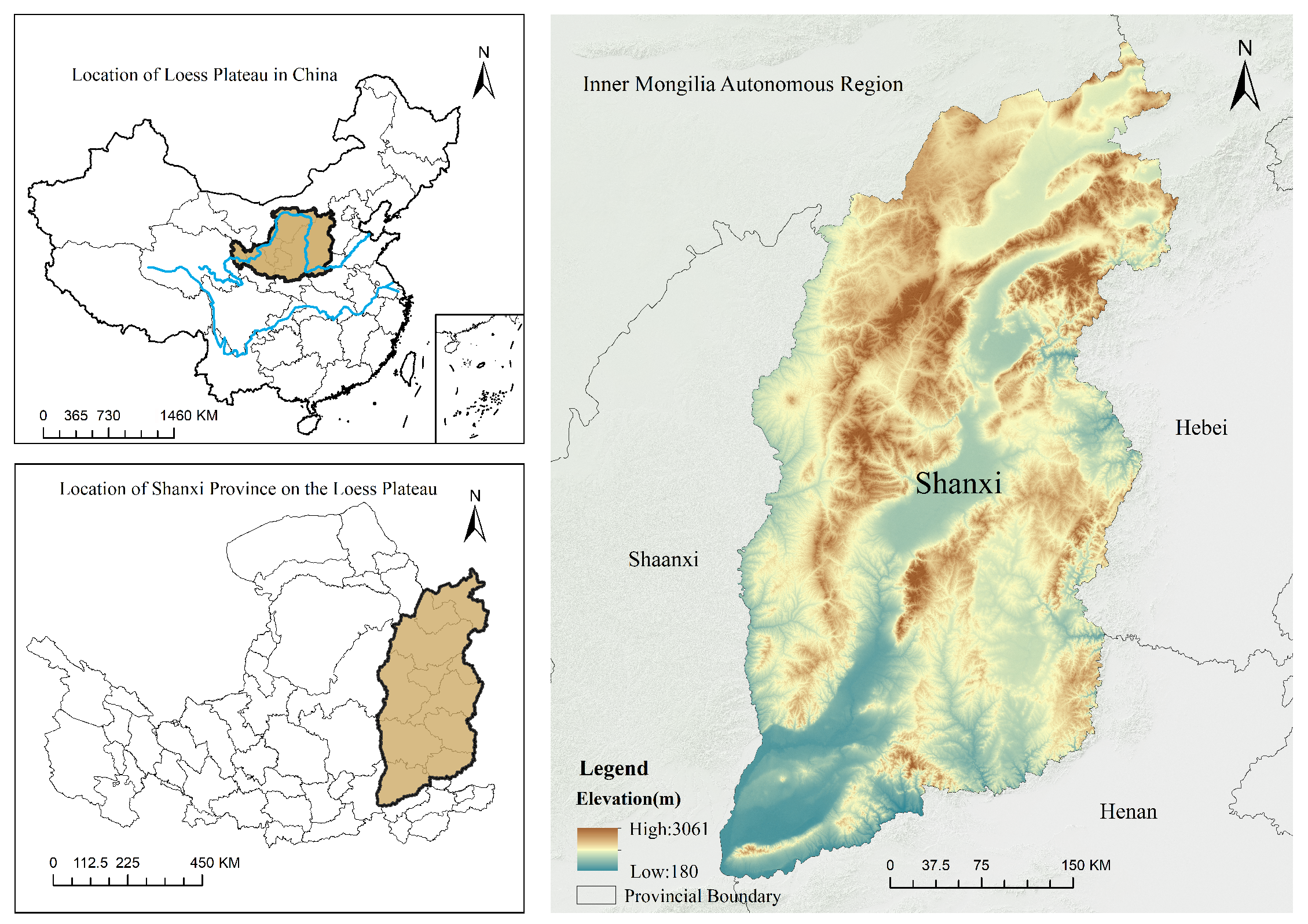
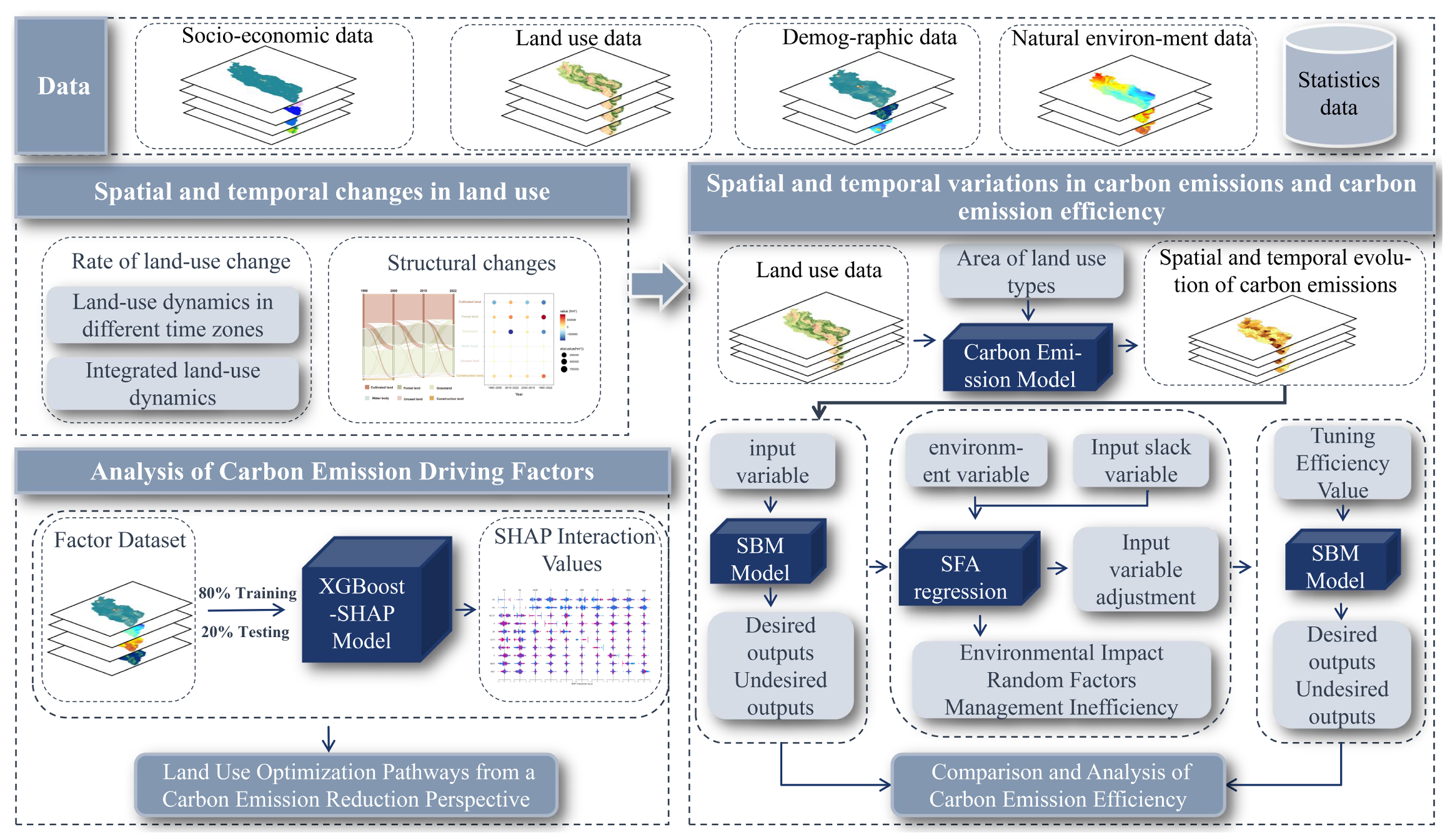
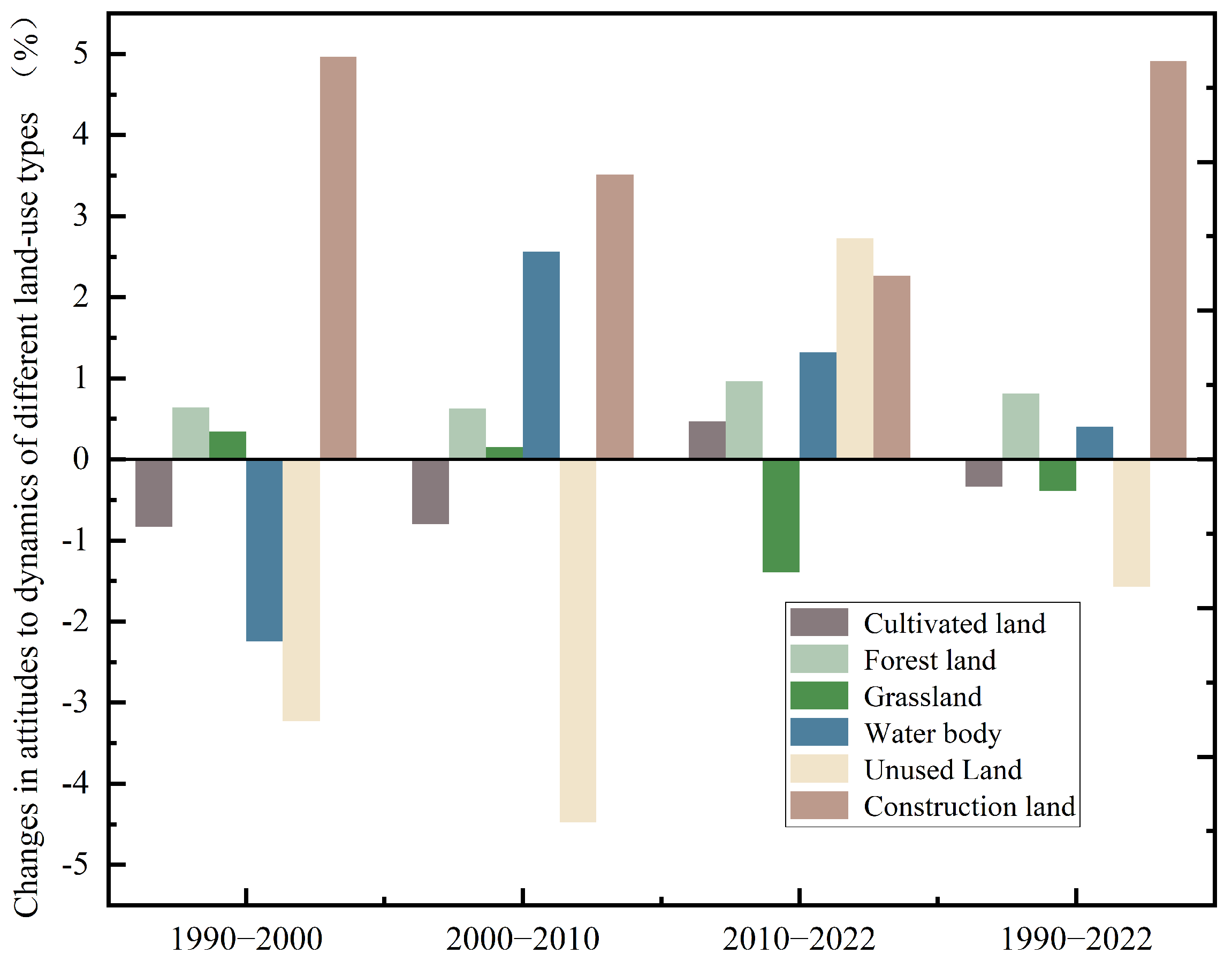

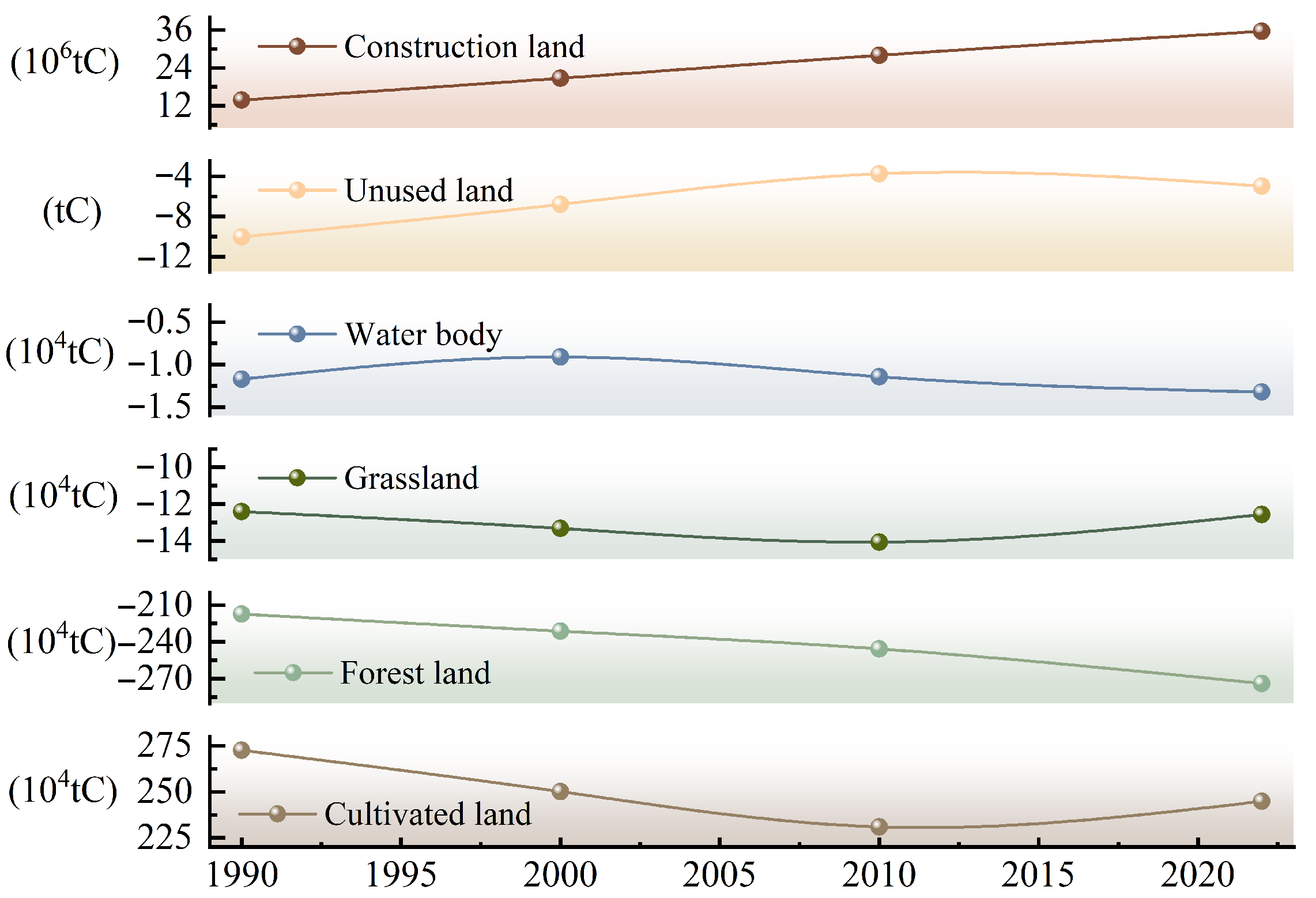
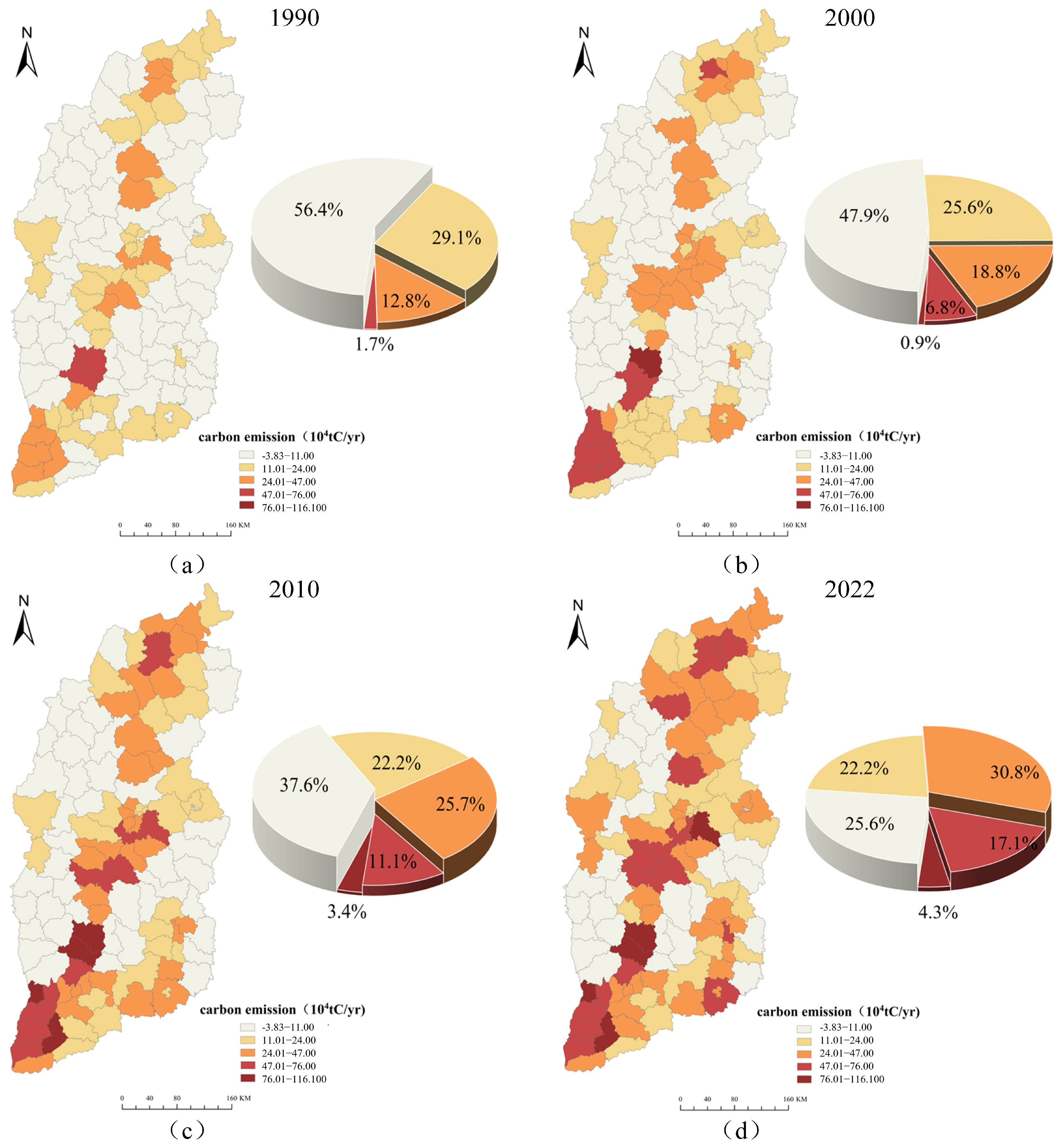

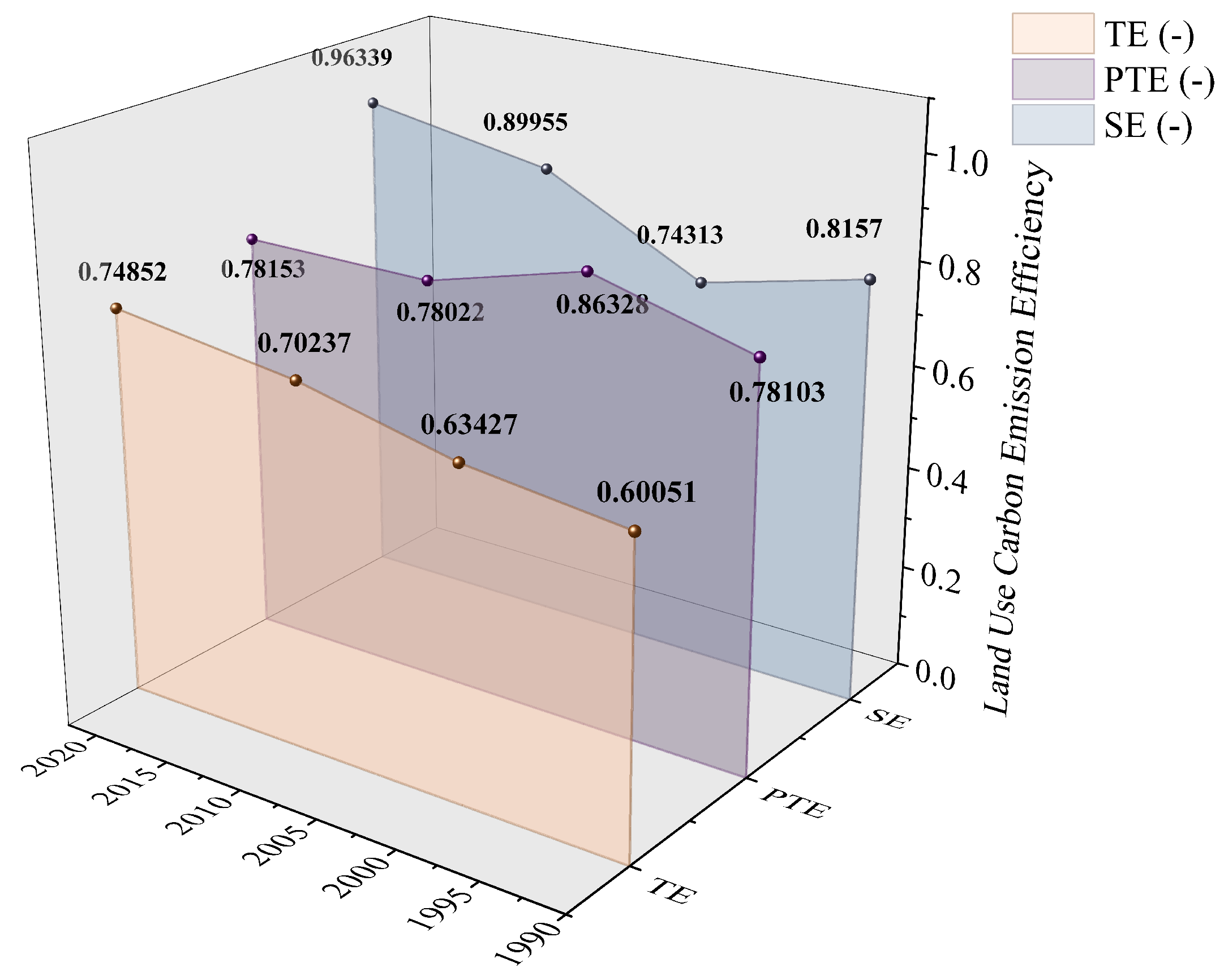
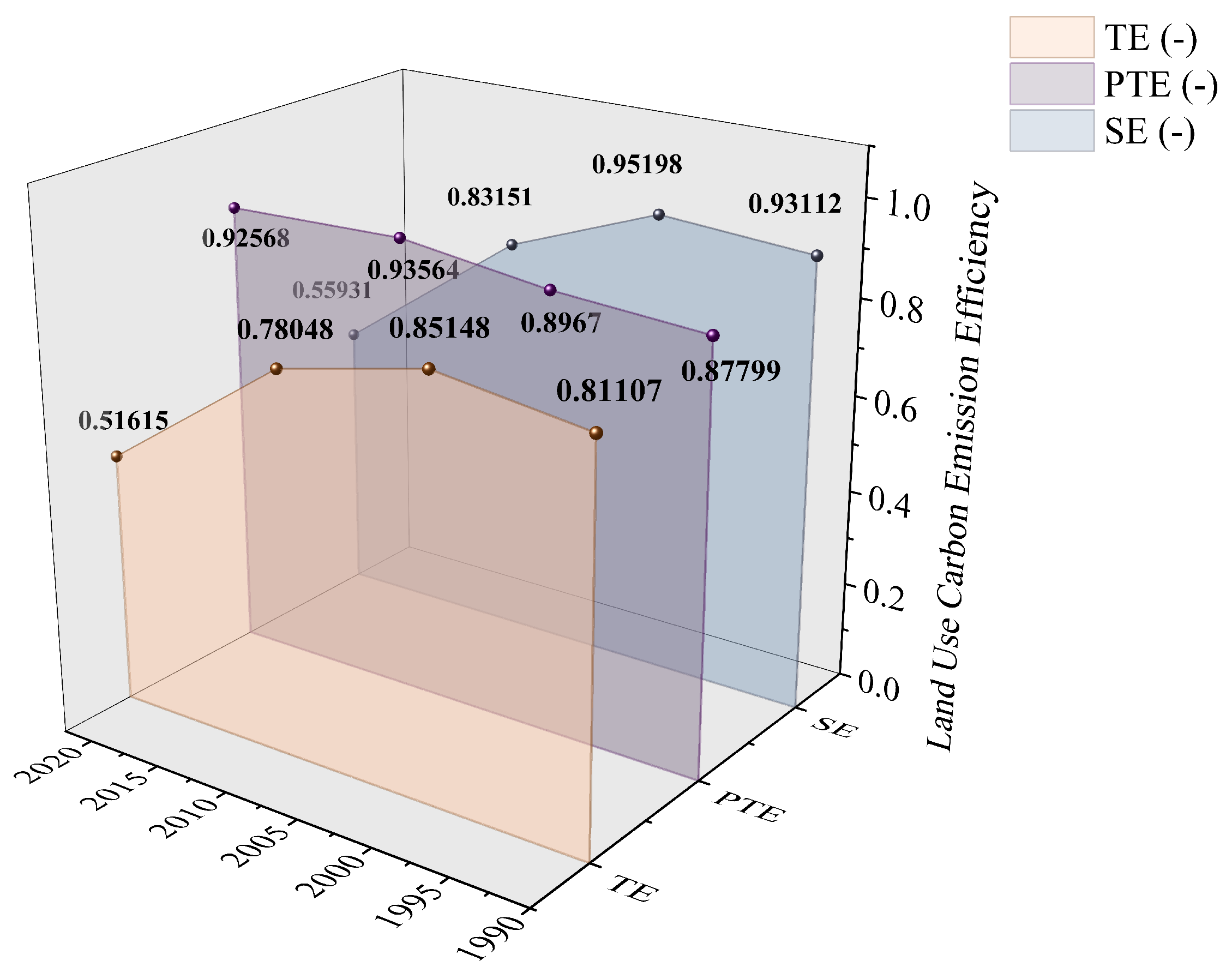
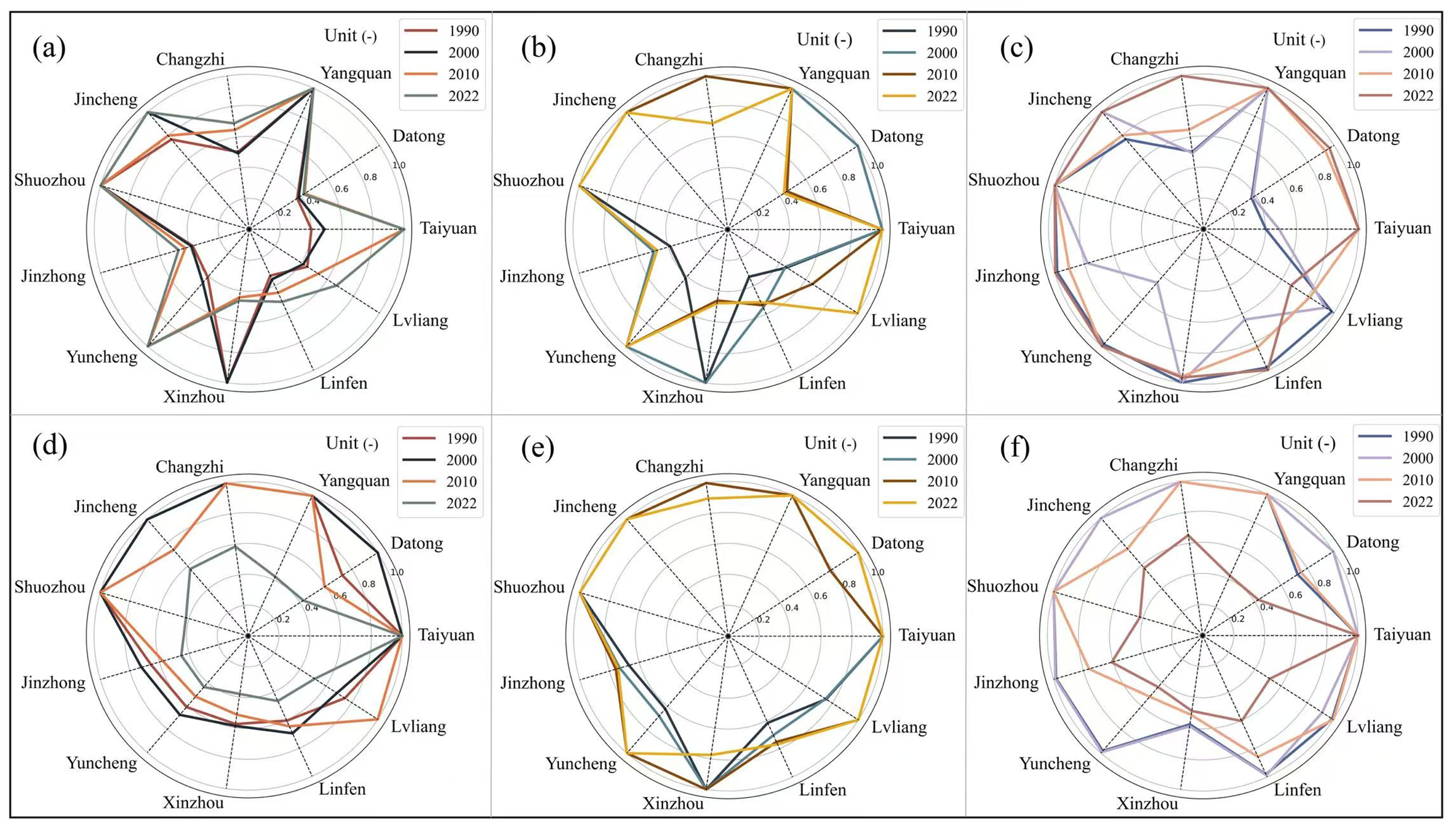
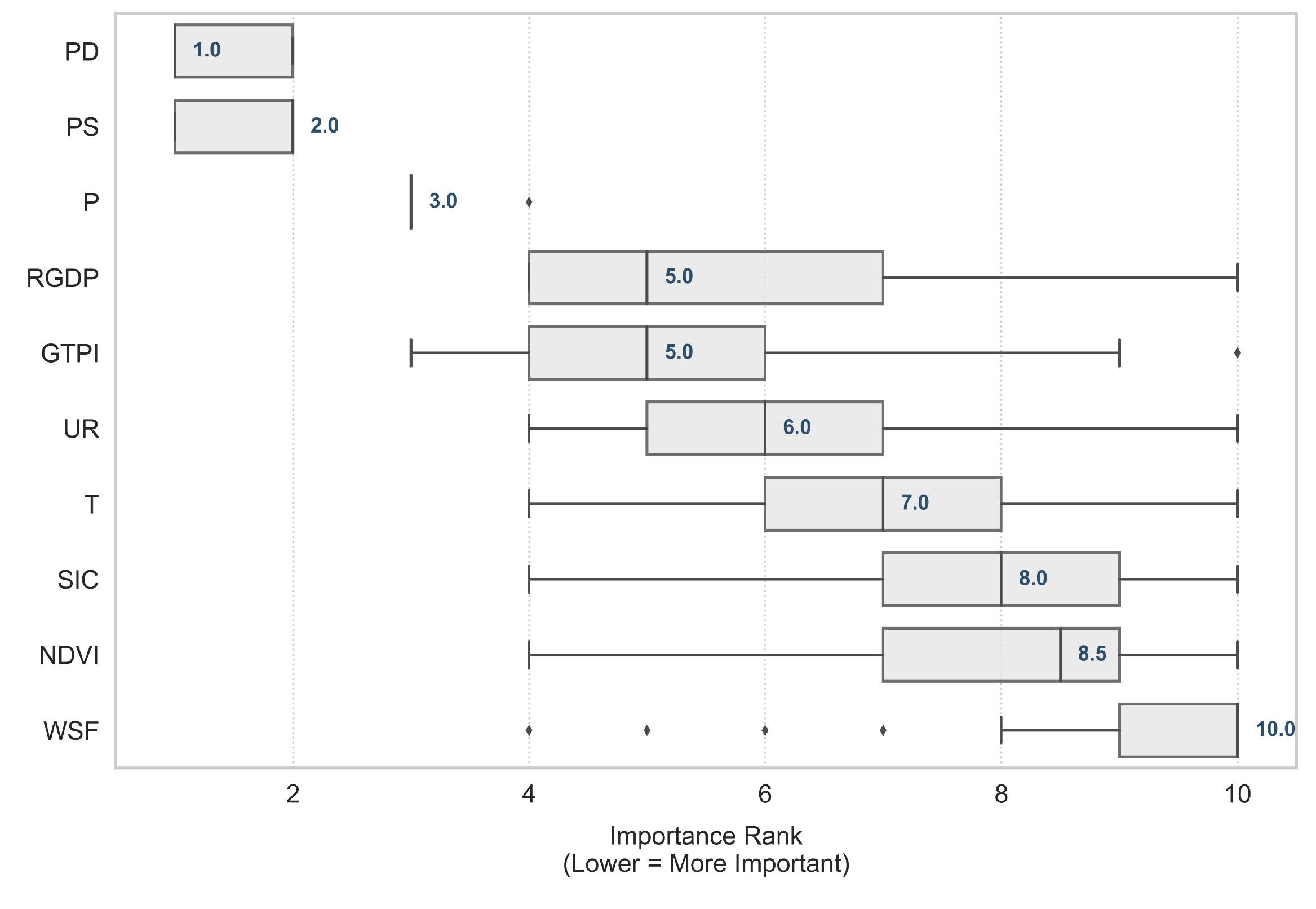
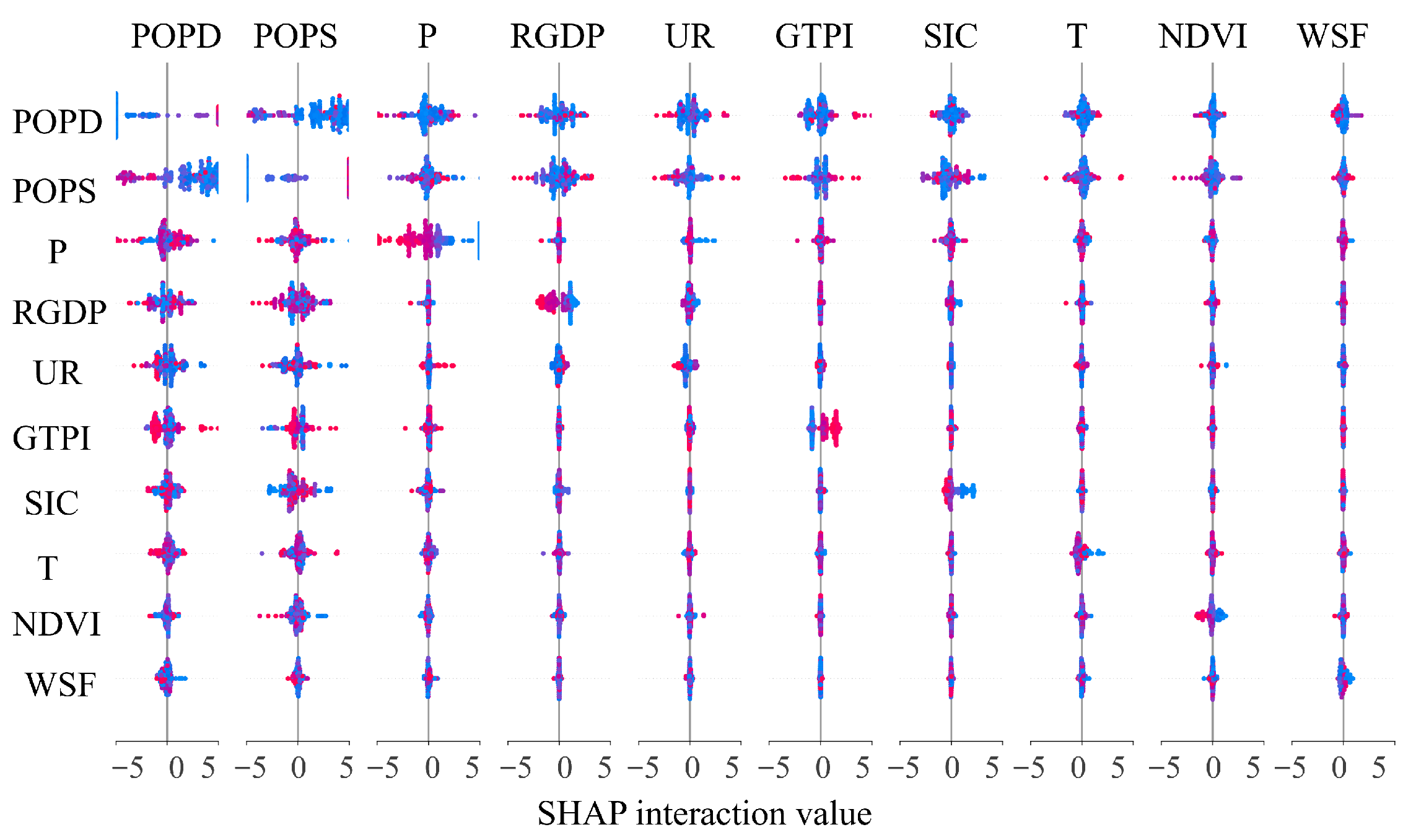
| Land Type | Calibration Parameter | Shanxi Value | National Value [33] | Adjustment Factor | Magnitude |
|---|---|---|---|---|---|
| Cultivated Land | Chemical Fertilizer Application | 100 kg·ha−1 | 85 kg·ha−1 | +18% | |
| Construction Land | Energy Consumption per Unit GDP | 0.5 tce·10 k CNY−1 | 0.4 tce·10 k CNY−1 | +25% | |
| Forest Land | Net Primary Productivity (NPP) | 200 kg·ha−1 | 227 kg·ha−1 | −12% | |
| Grassland | Net Primary Productivity (NPP) | 150 kg·ha−1 | 176 kg·ha−1 | −15% |
| Type | Cultivated | Forest | Grassland | Water | Unused | Construction |
|---|---|---|---|---|---|---|
| Value (t ha−1 a−1) | 0.422 | 0.005 | 42.970 |
| Category | Specific Indicator | Indicator Description | Unit | Data Source and Processing |
|---|---|---|---|---|
| Input variables | Capital stock | Fixed capital stock | CNY 100 million | Calculated based on the perpetual inventory method; data from Shanxi Statistical Yearbook and local statistical yearbooks. |
| Labor force | Year-end employed population | 10,000 persons | Statistical data from Shanxi Statistical Yearbook and local statistical yearbooks. | |
| Land | Carbon sources: construction land, cultivated land; Carbon sinks: forest land, grassland, water bodies, unused land | ha | Land use classification from the product of Huang Xin’s team (Wuhan University); city-level areas clipped in ArcGIS. | |
| Output variables | Desirable output | Regional gross domestic product | CNY 100 million | Data from Shanxi Statistical Yearbook and local statistical yearbooks. |
| Undesirable output | Total land use carbon emissions | 10,000 t | Derived by summing county-level land use carbon emissions estimates. | |
| Environment variables | Urbanization rate | Proportion of urban permanent residents to total population | – | Data from Shanxi Statistical Yearbook and local statistical yearbooks. |
| Economic development level | Per capita GDP | CNY | Data from Shanxi Statistical Yearbook and local statistical yearbooks. | |
| Industrial structure | Share of secondary industry value-added in RGDP | – | Data from Shanxi Statistical Yearbook and local statistical yearbooks. | |
| Population density | Total population divided by urban area | Persons/km2 | Population data from Shanxi Statistical Yearbook; land area derived from statistical yearbooks. | |
| Green technology progress index | Proportion of green patent grants to total patents | – | Patent data from the China National Intellectual Property Administration. | |
| Government intervention | Ratio of local fiscal expenditure to RGDP | – | Local fiscal expenditure and GDP data from Shanxi Statistical Yearbook and local statistical yearbooks. |
| Criterion Layer | Indicator Layer | Variable Definition | Unit |
|---|---|---|---|
| Economic Development | UR | Proportion of urban permanent residents to total population | – |
| RGDP | Final output of productive activities by regional units within a given period | CNY 100 million | |
| SIC | Percentage of secondary industry in industrial structure | – | |
| Technological Innovation | GTPI | Ratio of green patent grants to total patents | – |
| Land Use Patterns | NDVI | Reflects surface vegetation coverage | – |
| Human Activities | POPD | Population per unit area | Persons/km2 |
| POPS | Total permanent population | 10,000 persons | |
| HFD | Degree of human modification to land surfaces | – | |
| Natural Environment | P | Annual average precipitation | mm |
| T | Annual average temperature | °C |
| Environmental Variables | Capital Stock | Labor Force | Land Area |
|---|---|---|---|
| cons | 0.0016 | −0.0356 | −0.2515 |
| (0.1215) | (−0.7332) | (−2.2447) | |
| UR | 0.1056 *** | 0.2084 ** | 0.3311 |
| (3.3446) | (2.2623) | (1.3554) | |
| GOV | 0.0214 | −0.0516 | 0.6164 *** |
| (1.1091) | (−1.0935) | (4.0618) | |
| PGDP | −0.1639 *** | −0.1283 ** | −0.3113 |
| (−4.7281) | (−2.0378) | (−2.0818) | |
| GTPI | −0.0059 | 0.0880 *** | −0.0773 |
| (−0.3890) | (2.1377) | (−0.7280) | |
| POPD | 0.0233 | −0.2221 ** | −0.2300 |
| (0.6705) | (−2.2654) | (−0.9772) | |
| INS | −0.0032 | 0.0265 | 0.177 |
| (−0.2075) | (0.5667) | (1.4587) | |
| 0.0094 ** | 0.0041 ** | 0.0393 * | |
| (2.3624) | (2.3624) | (1.9756) | |
| 0.9638 *** | 0.4316 | 0.5981 | |
| (5.7327) | (1.9256) | (2.3976) | |
| Log-likelihood function | 101.4258 *** | 56.5474 *** | 17.7302 *** |
| (5.1431) | (4.1546) | (3.1842) | |
| LR one-sided error test values | 29.4255 *** | 40.3694 *** | 19.4377 *** |
| (4.2631) | (5.9847) | (4.3412) |
| Efficiency Measure | Stage | 1990–2000 | 2000–2010 | 2010–2022 |
|---|---|---|---|---|
| TE | Stage 1 | +0.034 | +0.068 | +0.046 |
| TE | Stage 3 | +0.040 | −0.071 | −0.264 |
| PTE | Stage 1 | +0.082 | −0.083 | −0.080 |
| PTE | Stage 3 | +0.019 | +0.039 | −0.010 |
| SE | Stage 1 | −0.073 | +0.156 | +0.064 |
| SE | Stage 3 | +0.021 | −0.120 | −0.272 |
| Efficiency Measure | Mean Change | Std. Dev. | Spearman’s |
|---|---|---|---|
| TE | 0.957 *** | ||
| PTE | 0.91 *** | ||
| SE | 0.966 *** |
| City | TE-p5 | TE-p50 | TE-p95 | SE-p5 | SE-p50 | SE-p95 |
|---|---|---|---|---|---|---|
| Taiyuan | 0.521 | 0.563 | 0.602 | 0.632 | 0.702 | 0.768 |
| Datong | 0.458 | 0.502 | 0.543 | 0.554 | 0.621 | 0.685 |
| Yangquan | 0.602 | 0.648 | 0.691 | 0.587 | 0.662 | 0.733 |
| Changzhi | 0.487 | 0.531 | 0.574 | 0.612 | 0.683 | 0.751 |
| Jincheng | 0.534 | 0.577 | 0.618 | 0.663 | 0.735 | 0.803 |
| Shuozhou | 0.423 | 0.467 | 0.510 | 0.522 | 0.590 | 0.656 |
| Jinzhong | 0.465 | 0.509 | 0.552 | 0.578 | 0.648 | 0.715 |
| Yuncheng | 0.441 | 0.485 | 0.527 | 0.598 | 0.668 | 0.736 |
| Xinzhou | 0.398 | 0.442 | 0.485 | 0.501 | 0.569 | 0.635 |
| Linfen | 0.452 | 0.496 | 0.539 | 0.562 | 0.631 | 0.698 |
| Lvliang | 0.411 | 0.455 | 0.498 | 0.534 | 0.602 | 0.668 |
| Median IPR | 0.084 | 0.136 |
| Fold | RMSE | |
|---|---|---|
| 1 | 0.635 | 10.570 |
| 2 | 0.844 | 8.848 |
| 3 (Region 2) | −0.055 | 16.602 |
| 4 | 0.628 | 11.840 |
| 5 | 0.696 | 16.055 |
| Average | 0.550 | 12.783 |
| Feature | Overall Mean | Region 2 Mean | Relative Difference | Implication |
|---|---|---|---|---|
| WSF | 15.77 | 18.13 | +15.0% | Elevated anthropogenic intensity |
| UR | 0.62 | 0.67 | +11.2% | Higher urban density and energy use |
| T (°C) | 7.66 | 7.10 | % | Colder climate, increased heating demand |
| P (mm) | 549.04 | 439.74 | % | Drier conditions, weaker natural sinks |
| NDVI | 0.42 | 0.31 | % | Lower vegetation cover, diminished ecological regulation |
Disclaimer/Publisher’s Note: The statements, opinions and data contained in all publications are solely those of the individual author(s) and contributor(s) and not of MDPI and/or the editor(s). MDPI and/or the editor(s) disclaim responsibility for any injury to people or property resulting from any ideas, methods, instructions or products referred to in the content. |
© 2025 by the authors. Licensee MDPI, Basel, Switzerland. This article is an open access article distributed under the terms and conditions of the Creative Commons Attribution (CC BY) license (https://creativecommons.org/licenses/by/4.0/).
Share and Cite
Chen, A.; Duan, H.; Li, K.; Shi, H.; Liang, D. A Three-Stage Super-Efficient SBM-DEA Analysis on Spatial Differentiation of Land Use Carbon Emission and Regional Efficiency in Shanxi Province, China. Sustainability 2025, 17, 9086. https://doi.org/10.3390/su17209086
Chen A, Duan H, Li K, Shi H, Liang D. A Three-Stage Super-Efficient SBM-DEA Analysis on Spatial Differentiation of Land Use Carbon Emission and Regional Efficiency in Shanxi Province, China. Sustainability. 2025; 17(20):9086. https://doi.org/10.3390/su17209086
Chicago/Turabian StyleChen, Ahui, Huan Duan, Kaiming Li, Hanqi Shi, and Dengrui Liang. 2025. "A Three-Stage Super-Efficient SBM-DEA Analysis on Spatial Differentiation of Land Use Carbon Emission and Regional Efficiency in Shanxi Province, China" Sustainability 17, no. 20: 9086. https://doi.org/10.3390/su17209086
APA StyleChen, A., Duan, H., Li, K., Shi, H., & Liang, D. (2025). A Three-Stage Super-Efficient SBM-DEA Analysis on Spatial Differentiation of Land Use Carbon Emission and Regional Efficiency in Shanxi Province, China. Sustainability, 17(20), 9086. https://doi.org/10.3390/su17209086






